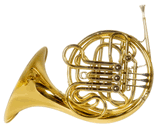|
French
Horn
Suggested
Range
About Our
Suggested
Ranges
|
 Effects Effects
Glissando or "Rip"
There are a couple of unique sounding French
horn effects that are worth mentioning. The first effect is the
fast
- sometimes called a “rip”- that a horn
can perform between two notes. The direction of this glissando is always
upward, and the distance from that first note can be anywhere from a whole
step to an octave above. This extremely powerful and dramatic effect is
used to give extra weight and drama to the final note of the glissando,
which is usually on a downbeat. The higher the final note, and the greater
the range between the two notes, the more dramatic the effect will be.

Stopped (Hand Mute) effect or Metal Mute effect
A second effect commonly performed by the French
horn is the “stopped” effect, or hand mute. This is a menacing,
snarl-like effect that creates quite a unique orchestral color. The horn
player performs this by sticking his hand completely inside the horn. Because of certain limitations
of this technique, such as pitch accuracy, modern composers have requested
that horn players use “metal” or “brass” mutes instead. While this provides
a louder, and more accurately pitched note, it does take a few seconds
to insert and remove the mute. When writing for any brass instrument,
always allow enough time for the player to make these moves.

|
|